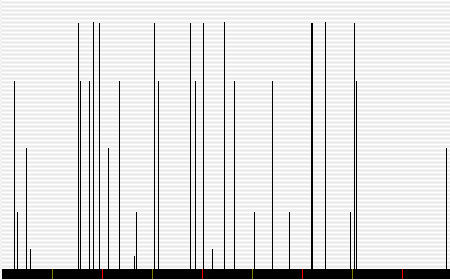/flash/alife.swf
The Danger of Loyalty
Here's the first result from my recent alife experiments, and it's quite a surprise. This experiment looks at the effect of advertising in Weblog communities -- the sort of traffic-building ads that have recently been popular at MetaFilter, DayPop, Kvetch, and a variety of other weblog portals.
We begin with a collection of 600 simulated weblogs (or weblets), each different but each equally good. At the beginning of the experiment, each weblog receives a small amount of traffic every day from search engines, directories, and personal friends.
To increase traffic, our simulated webloggers may purchase small ads on other weblogs. They also sell ads to other webloggers. The price of ads is set so that the cost of acquiring a new reader is equal to the revenue they receive selling ads the reader will view -- buying and selling ads is, on average, a break-even proposition. Every weblog offers the same cost and click-through rate.
If a weblog does manage to get additional traffic, of course, it can sell more ads -- assuming someone wants to buy them. We assume that readers who find a weblog through an advertisement will continue to read it for the next few days, but most will eventually lose interest; the spike of visitors created by a single day of advertising lasts about a week.
When we begin our study, each weblog receives an identical number of hits. Every day, our busy webloggers take 20% of their ad budget and find one or more sites on which to advertise.
After a month has passed, some weblogs are getting a little bit more traffic -- they were lucky (or had hard-working simulated sales workers) and got a few more advertising orders than the others. The extra advertisements generated extra cash, letting them get a few extra visitors. In this particular (and totally artificial) case, the average weblog gets 23,000 hits a day. The busiest sites get about 32,000 hits, the least successful get about 15,000. Everybody has readers. A year later, things look pretty much the same.

Notice, incidentally, that though none of these sites is very big, the community of weblogs gets more than a ten million hits a day. Six hundred small sites is a big site! (Remember, these numbers are artificial; scale them up or down to match what you're used to seeing in your logs)
So far, our simulated webloggers have been making new advertising decisions every day. What happens if they show a little loyalty? We change the way our weblets buy ads: now, instead of picking new sites every day, they pick some sites they like and continue to advertise there. (If a site goes away, or if we want more advertising than it can provide, we can add new sites to our ad roster)
The effect of the new policy is dramatic. After a month has passed, some sites are getting a lot of traffic, and some are getting almost none. They still receive a few hits from friends and search engines, but they can't sell many ads and so can't buy ads. An artificial weblog "a-list" is starting to emerge.

After a simulated year, things have gone from bad to worse. The average number of weblog readers is unchanged, but all the traffic is concentrated in a few big weblogs. The overwhelming majority of weblogs in our example are no longer able to advertise and are receiving no ads, while the top 16 sites share about 4 million hits a day. Where once the smallest artificial weblogs were about half as big as the biggest, now the big logs are 25 times the size of the small ones.

What Happened Here?
Our artificial webloggers would like to choose the best places to advertise, but since all the weblogs in our study are equally good, they end up choosing at random. One the first day, some lucky weblogs will have several advertisers, and some unlucky weblogs will have none. In the first example, this doesn't matter very much: a weblog that was unlucky today may be lucky tomorrow, and the effect of a single ad dies out after a week or two in any case. The result is a healthy community where everyone gets readers and everyone gets some ad income.
In the second study, though, loyalty freezes the initial advantage of the lucky web sites. Webloggers who are lucky enough to have two or three "friends" on the first day may retain those friends indefinitely. Some of those friends will start to get rich from advertising, and so they'll be able to buy a lot of advertising from their friends. Circles and clusters of friends reinforce each other with advertising money and traffic. Since all the weblogs are equally good, this advantage is sufficient to transform the entire community.
Is advertising the problem?
The effect is not limited to advertising or to the corrupting influence of money. Indeed, if we substitute the blogroll for the text ad, no money changes hands and we have the same effect. The problem isn't money, it's narrowness.
The moral of the story is that responsible webloggers need to avoid getting into a rut of reading and citing the same sites all the time. Reading widely, and changing your weblogging habits often, are the best ways to keep your own weblog and the entire weblog community fresh and lively.
This might all be wrong!
This is merely the first of what I hope will be a series of experiments. It was performed with jury-rigged software; I think it operates as I've described it, but it hasn't been extensively tested nor have the results been validated. If you enjoy programming, you should be able to reproduce these results yourself; feel free to contact me with questions. or clarifications.